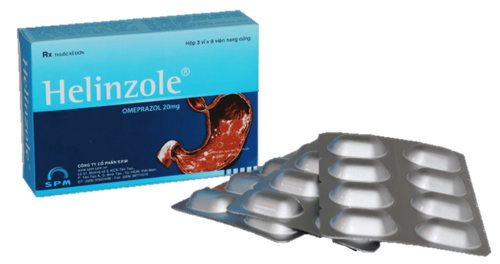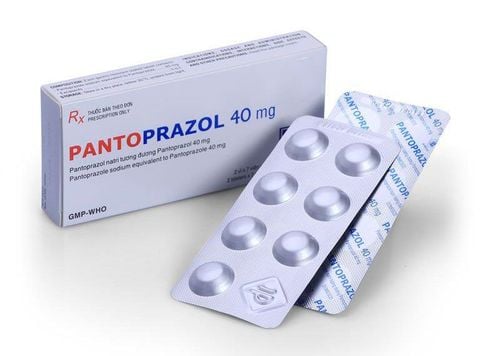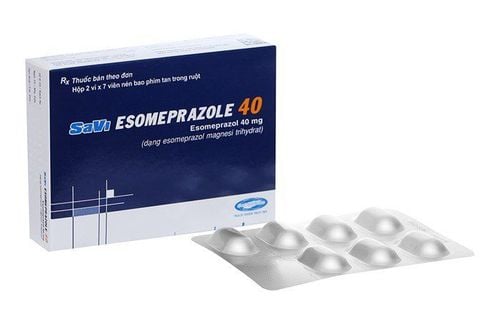This is an automatically translated article.
Coroclesstra contains the active ingredient pantoprazol, a proton pump inhibitor that inhibits gastric acid secretion. The drug is indicated in the treatment of peptic ulcers, gastroesophageal reflux disease, conditions that cause pathological acid secretion such as Zollinger - Ellison syndrome.1. What is Coroclesstra?
Coroclesstra has the active ingredient Pantoprazol, a proton pump inhibitor. After absorption, the drug is converted to the active form sulfenamide, which irreversibly binds to the proton pump H + / K + - ATPase on the cell surface of the stomach wall, thereby inhibiting this enzyme, preventing excretion secrete acid into the stomach. In general, pantoprazole has an inhibitory effect on basal acid secretion and also when the stomach is irritated by any stimulant.
2. Uses of the drug Coroclesstra
Coroclesstra is indicated in the following cases:
Treatment of gastroesophageal reflux - oesophagitis. Treatment of gastric and duodenal ulcers. Prophylaxis of gastric and duodenal ulcers caused by the use of non-steroidal anti-inflammatory drugs. Treatment of conditions that cause pathological hyperacidity such as Zollinger-Ellison syndrome. Coroclesstra is contraindicated in patients with known hypersensitivity to any of its ingredients.
3. What are the side effects of Coroclesstra?
Patients using Coroclesstra may experience undesirable effects including:
Common:
Body as a whole: Fatigue, dizziness, headache. Skin: Rash, urticaria. Gastrointestinal: Dry mouth, abdominal pain, nausea, vomiting, flatulence, constipation, diarrhea. Musculoskeletal: Muscle and joint pain. Uncommon:
Whole body: Asthenia, dizziness, insomnia. Skin: Itching. Liver: Increased liver enzymes. Rare:
Whole body: Profuse sweating, peripheral edema, anaphylaxis. Skin: Macular rash, acne, alopecia, exfoliative dermatitis, angioedema, erythema multiforme. Digestive: Stomatitis, flatulence, digestive disorders. Eyes: Blurry vision, fear of light. Nervous: Agitation or inhibition, tinnitus, tremor, confusion, insomnia, somnolence, hallucinations. Blood: Eosinophilia, leukopenia and thrombocytopenia. Endocrine: Impotence or impotence in men. Urinary: Hematuria, interstitial nephritis. Liver: Hepatitis, jaundice, hepatic encephalopathy, increased triglycerides.
4. What is the dose and how to use Coroclesstra?
Coroclesstra is taken orally, the patient should take it once a day in the morning. When taking the patient must swallow the tablet whole, do not break, chew or break the tablet.
Treatment of gastroesophageal reflux - esophageal reflux: Coroclesstra is recommended to take 20-40 mg/time/day in the morning for 4 weeks, can be increased to 8 weeks if necessary. In patients with esophageal ulcers that do not heal after 8 weeks of treatment, the course of treatment may be extended up to 16 weeks. The maintenance dose is 20-40 mg per day. Treatment of benign gastric ulcer: Coroclesstra 40 mg once daily is recommended for 4 - 8 weeks. Duodenal ulcer: 40 mg once daily is recommended, for 2-4 weeks. To eradicate Helicobacter pylori, it is necessary to combine Coroclesstra with antibiotics. Prophylaxis of peptic ulcers caused by non-steroidal anti-inflammatory drugs: 20 mg orally once daily is recommended. Treatment of Zollinger-Ellison syndrome: The recommended starting dose is 80 mg once daily, then adjusted according to the patient's response, possibly increasing the dose to 240 mg daily. If the daily dose is greater than 80 mg, it should be divided into 2 doses per day.
5. What are the precautions when using Coroclesstra?
Effects on the liver: No dosage adjustment of Coroclesstra is required for liver dysfunction. Before using Coroclesstra, the possibility of gastric cancer must be excluded because the drug may mask symptoms or delay the diagnosis of cancer. Coroclesstra should be used with caution in patients with liver disease. Serum concentrations of the drug may be slightly increased, but no dose adjustment is required. Avoid taking Coroclesstra if you have cirrhosis or severe liver failure. If necessary, reduce the dose of Coroclesstra or use it every other day. Regular monitoring of liver function is recommended while taking the drug. Use Coroclesstra with caution in patients with renal failure, the elderly. Pregnancy: There are no adequate studies on the use of pantoprazole in women during pregnancy. Animal studies have demonstrated that pantoprazole crosses the placenta, but no teratogenic effects have been observed. Therefore, Coroclesstra should only be used when clearly needed during pregnancy. Lactation: It is not known whether pantoprazole is excreted in human milk. Based on the rat carcinogenic potential of pantoprazole, consideration should be given to discontinuing nursing or discontinuing the drug, depending on the role of pantoprazole in the mother. Drug Interactions: Although pantoprazole is metabolised by the cytochrome P450 system in the liver, it does not inhibit or induce this enzyme system. No clinically significant interactions were observed between Pantoprazol and commonly used drugs such as Diazepam, Phenytoin, Nifedipine, Digoxin, Warfarin or oral contraceptives. Similar to other proton pump inhibitors, pantoprazole may reduce the absorption of certain drugs whose absorption is dependent on gastric pH, such as azole antifungals. Above is information about the uses, dosage and side effects of Coroclesstra. Note, Coroclesstra is a prescription drug, patients need to use the drug as prescribed by the doctor, absolutely do not self-treat at home.













